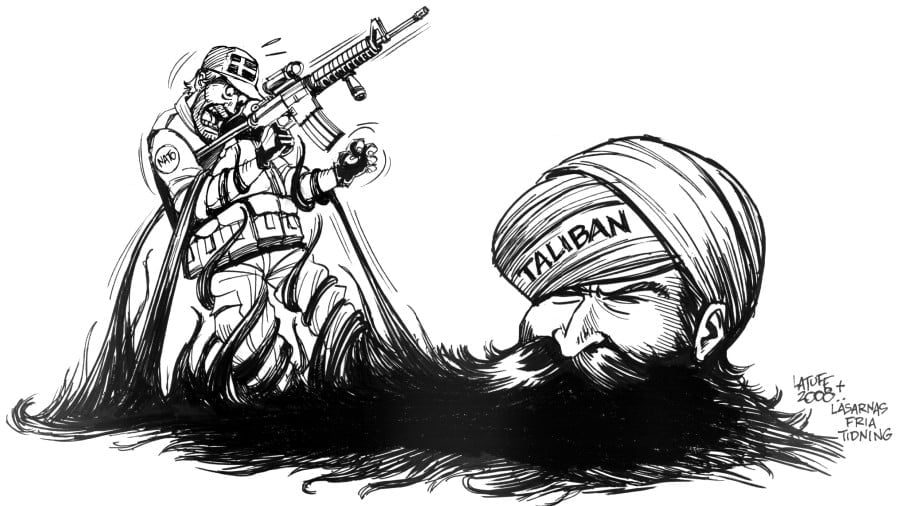After Key China-Russia-Iran-Pakistan Meeting, Moscow Official Says Taliban Control 50% of Afghanistan
Mapping the Taliban
Last week saw a historic meeting in Islamabad between the intelligence chiefs of China, Russia, Pakistan and Iran. While the details of the meeting were not disclosed beyond statements implying that counter-terrorism was a dominating theme, it is a safe assumption that the war in Afghanistan was a major topic of discussion.
Today, following on from the intelligence shared between national partners, the Russian President’s special envoy on Afghanistan Zamir Kabulov has stated that the Taliban controls over half of Afghan territory at the present time. Due to the remote geography of much of Afghanistan, it is difficult to say with exactitude just how much territory of Afghanistan the Taliban control, with most estimates being anywhere between 35% and 65% of all Afghan territory.
The revelation from Kabulov is therefore crucial as it represents Russia’s official determination of a highly contested question regarding just how profound the resurgence of the Taliban has been since 2001. Equally important to determining how much territory the group which remains outlawed in Russia controls, is determining how much political influence the Taliban have and where. The answer to this comes relatively easily. Perhaps ironically, the Taliban now control much of northern Afghanistan which in the 1990s was the base of the anti-Taliban coalition Northern Alliance which for a time was supported by Iran, Russia and India. Today not only has the internal political geography of Afghanistan changed but so too have international positions regarding the internal politics and disputes of Afghanistan.
The biggest shifts in policy among the concerned powers since the 1990s is as follows:
–While still outlawed in Russia, Moscow now accepts that in a clearly articulated peace process, certain elements of the Afghan Taliban will have to be involved in a negotiated political settlement within Afghanistan as there is no other realistic way to hold Afghanistan together as a peaceful state.
–While still clearly ideologically opposed to the Taliban, Iran has decided to back a general peace process rather than fund specific anti-Taliban factions as was the case in the 1990s when after 1996 the Taliban formed a theocratic government in Kabul.
–Going back to the 1980s, China’s Afghan policy was framed within the context of the Sino-Soviet split which saw neighbours on historically good terms act as rivals. This also helped to maintain good Sino-Pakistan relations even during the era of the widely pro-US General Zia. Now however, the Afghan policy of Beijing and Moscow is virtually identical as both states work closely in calls for a peace process as well as coordinating efforts to preempt a fragile situation on Afghanistan’s borders from becoming worse.
–In many ways, Pakistan’s position has remained the most consistent, certainly since the 1990s. Pakistan has historically feared Pasthun ethno-nationalism being used by Kabul or Kabul’s de-facto overlords as a means of stirring provocations inside Pakistan’s borders. Furthermore, the Inter-Services Intelligence (ISI) is aware that those who seek to threaten the unity and territorial integrity of Pakistan have and could continue to use Afghanistan as a base for terror operations in the south-western province of Balochistan.
Because of this, Pakistan has long sought a stable/united government in Kabul that neither has territorial ambitions which could threaten regional stability and likewise, Pakistan has sought internal security in Afghanistan in order for the country not to become a base of anti-Pakistan operations. Therefore, just as Pakistan has long asserted that Afghanistan requires stability combined with a good neighbourly policy of non-interference in the affairs of others, now Iran, China and Russia have come to embrace this pragmatic and security based position as the best possible way to end decades of conflict in Afghanistan.
As Iran’s southern province of Sistan and Baluchestan is now threatened by many of the same extremist forces that have long threatened Pakistan’s province of Balochistan, Islamabad and Tehran are now working ever more closely on coordinated strategies. This highly positive rapprochement between neighbours who prior to the 1980s were on extremely good terms is a crucial development in creating a united front of responsible nations in Asia.
In so far as Iran-Pakistan cooperation is required regarding neighbouring provinces, the Chief of Staff of the Iranian Armed Forces Major General Mohammad Hossein Baqeri is currently in Pakistan for a three day visit to discuss these matters in a clear sign that if anything, lats week’s meeting between Chinese, Russian, Iranian and Pakistani officials helped to strengthen ties between Tehran and Islamabad.
Russia restates calls for multiparty talks which include the Taliban
Zamir Kabulov defined Russia’s contemporary policies and goals for Afghanistan in the following way:
“History, including Afghan history, teaches us that problems must be resolved before they grow into a serious threat. In order to facilitate the process of launching negotiations we, already last year, we initiated dialogue of the so-called Moscow format. By the end of this summer, we will organise another meeting in this format, but it needs thorough preparations to yield, if not a breakthrough, but a visible result. We want it to be the beginning of real progress, which is possible only when Taliban begins to speak with the Afghan government or with a more or less broad spectrum of the Afghan establishment”.
Kabulov reiterated that the continued US presence in Afghanistan makes such a format less easy to achieve because rather than viewing the Kabul government as a diverse coalition of ethno-political forces, the Taliban continues to view the government as a US puppet in spite of some recent signs of an partial independent streak. Kabulov continued, “They [Taliban] don’t’ want to hold talks with it [Kabul government] but want to negotiate separately with the Americans”.
A united front
The views expressed by Kabulov encouraging a multi-party dialogue process which is inclusive of the Taliban combined with a multinational format for hosting these discussions is now the favoured format not only in Russia but also in China, Pakistan, Iran and the concerned central Asian republics. By contrast, the US and India remain reticent to embrace such a format.
For the US, it is a matter of seeking to prolong the Afghan conflict so as to create a permanent roadblock to further trade inter-connectivity between China, Pakistan, Afghanistan and Iran while it also serves the US strategic interest to have troops and military resources on the borders of Pakistan and Iran in particular. Finally, as part of the overtly cynical US strategy in Afghanistan, while much of the violence in the country prevents the US from exploiting Afghanistan’s mineral resources to the fullest extent, the matter is now one of keeping others away from Afghanistan’s natural mineral wealth as part of a wider stalling tactic designed to retard the progress of regional cooperation between sovereign nations.
For India, the Afghan issue remains a simple matter of not wanting to lose the country as a current and future base from which to covertly launch anti-Pakistan provocations. Afghan territory has been useful to India in this way in the past and for elements in India’s RAW (intelligence agency) Afghanistan is still coveted for this purpose. Thus, for both Washington and New Delhi a policy of “the worst the better” can by contrasted with a Russian, Chinese, Iranian, Pakistani and pan-central Asian policy of “the last best hope for peace and stability is a genuine and meaningful all parties format”.
Conclusion
While the US remains the most powerful singular military force in Afghanistan, in many respects the Taliban are once again the most potent political force in the country. Paradoxically this is the case both because of and in spite of the US presence. On the one hand, the fact that the Taliban have been able to politically flourish in recent years is symptomatic of the disconnect between obvious American military power and America’s political powerlessness in Afghanistan. At the same time, while the Taliban were once considered taboo for some Afghans including in the Pashtun ethnic community, after years of a seemingly endless US presence in the country, the Taliban are now viewed by many Pashtuns as a kind of resistance organisation which is supported because the group is seen as an effective alternative to the US model occupation that has been rubber stamped by Kabul.
This manifold crisis is one that China, Russia, Pakistan, Iran and the central Asian republics have committed to solve through collective peace making, although even this offers no guarantee of a Kabul-Taliban ceasefire let alone of a future US withdrawal. In any case, this is the only viable option when it comes to attempting anything resembling a lasting peace.







